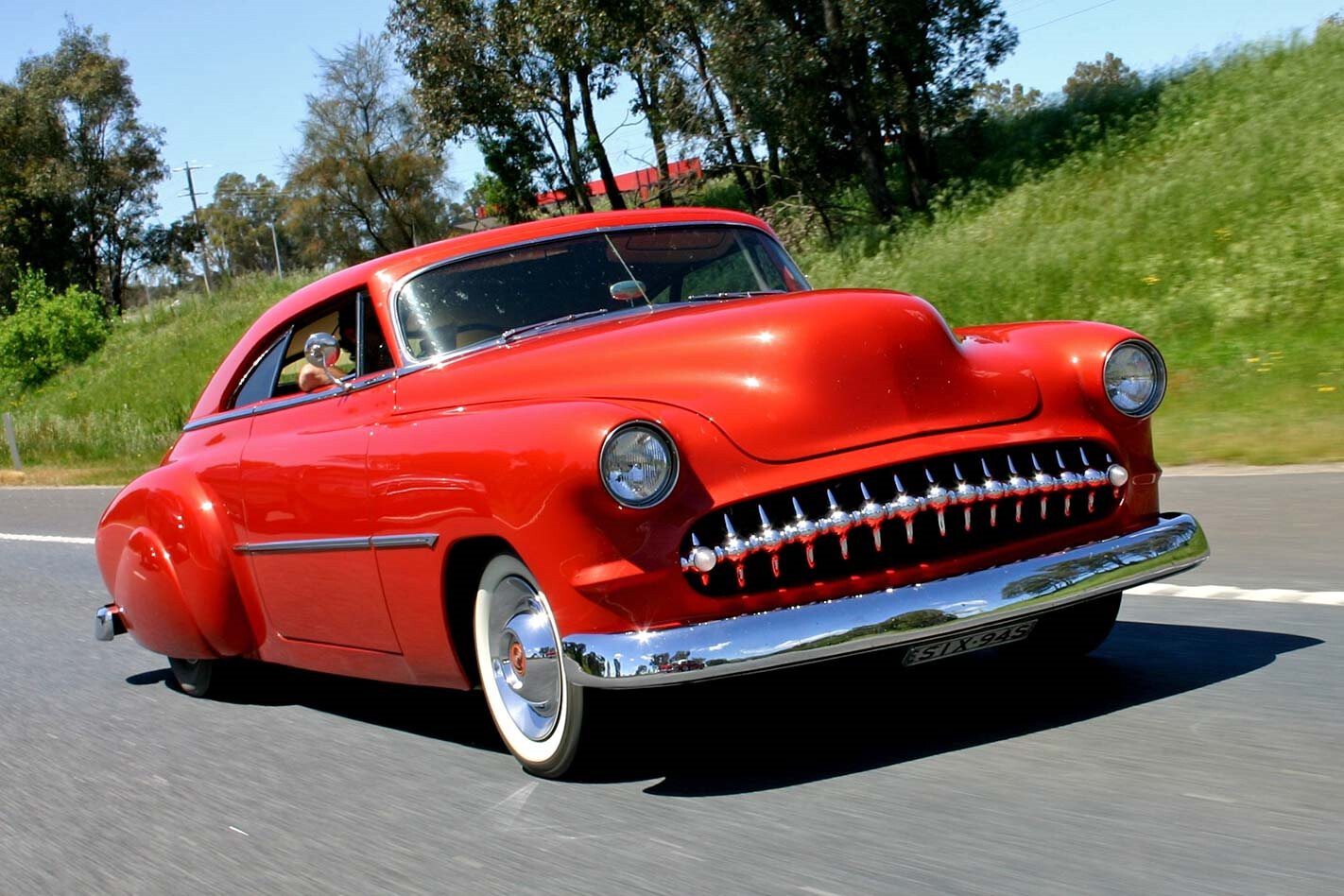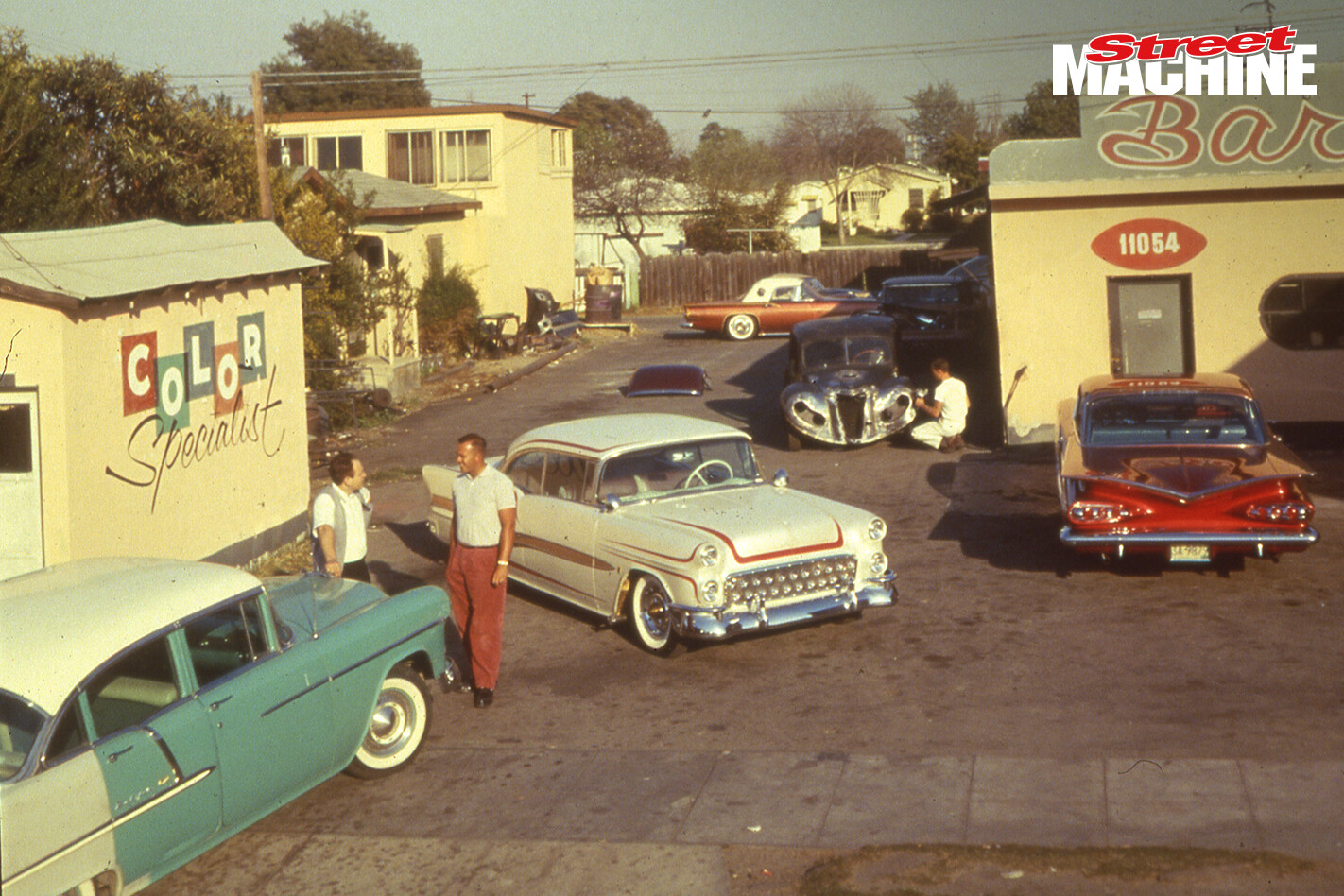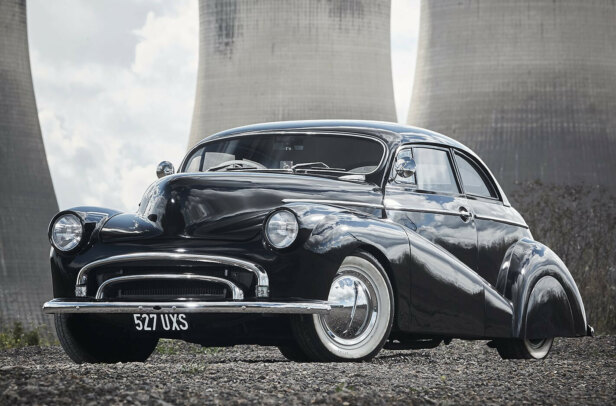This story on Michael Morris’s Chev two-door was originally published in the October 2005 issue of Street Machine magazine
I’VE always loved early Barris and Watson-style cars, so I did a concept drawing and tried to stick to it.” Sounds simple, really – for a signwriter, Michael Morris is a good custom car builder.
If you’ve got no idea who the hell Michael is talking about, then take a good look at the super-smooth Chevy gracing these pages. Back in the early 50s, the Barris brothers were the leading customisers of nearly new cars.
The whole aim of customising a car was to improve its looks, giving it a more flowing design than the often bulbous efforts of the design studios of that era, often using parts from upmarket cars to give the look of a more expensive ride. Which is precisely what Michael had planned for his Chevy, but more on that later.
Work had been started on the car when Michael bought it in 1998. It had been blasted and treated to some new sills, door skins and repaired rear quarters. The roof had also been removed and the front pillars chopped four inches, but six inches of the old roof were still attached.
Obviously the roof had to be sorted but that could wait. The first thing that went was the original chassis, replaced with an HQ panel-van unit.
“It was a good idea at the time but proved to be a hell of a lot more work. In the end I should’ve just replaced the front clip,” Michael explains. By the time he’d got the job done, it had a different wheelbase and all-new crossmembers.
Michael’s mate and well-known Central Coast hot rodder Al Fountain helped with the chassis swap, which involved cutting out the pristine floor from just behind the front seat. This was then fitted over the replacement chassis and new body mounts were made.
Next a call was put out to Mark at Central Coast Sheet Metal who folded up new floor and boot panels for Michael and Al to weld in. Now that the major part of the body was fitted up to the chassis, the rest of the hanging panels could go on. This is the part where the real customising begins.
A common trick on these early Chevys is to fit a ’53 model grille opening. As Michael wasn’t interested in reinventing the wheel, he followed this tried-and-true formula – welding the whole lot in so that it formed a single-piece front end. Another great old custom trick is to use ’52 Ford headlight rings to form a very smooth pair of frenched headlights. The bonnet has also been lengthened, peaked and the corners have all been rounded.
That row of shiny grille teeth is pretty impressive but about as real as Pamela Anderson’s boobs and made of similar stuff – plastic! That’s right boys and girls, a stock ’53 Chev only has three grille teeth, so Michael had Jason Hall take a mould of them and cast them in plastic.
Michael then spent many days filing and smoothing them as well as shortening the end two so that they would fit in the opening. The shorter teeth were fitted with ’58 Chev lenses and LED lights and the whole lot was plastic chromed. So although not technically real, just like Pammy’s boobs, they sure look good.
The tail-lights are also frenched and feature custom-made lenses and more LEDs. This may bug some of the more traditional builders out there but we all know how dim original tail-lights are and considering the standard of driving out there, a bright set of tail-lights is a valuable safety feature.
Now, how about this technique of using parts from more upmarket models to give a classier look? Well, the bumpers on the Chev were originally bolted to a ’50 Pontiac. Michael welded the bolts to the inside and then – yet another classic custom trick – mounted the bumpers upside-down. The super-cool numberplate surround on the rear is from a good ol’ FC Holden.
Smoothing out both ends of the car are filler panels between the body and bumpers as well as a new rear roll pan. Those swoopy fender skirts are ’36 Ford items that have been lengthened a touch. So there goes the theory about using new stuff but there’s always an exception to test every rule and the number-one tip in customising is to use whatever works!
By now most people would be happy with the degree of customising the boys had achieved. But not Michael, and not on this car.
“All this was easy compared to the roof and the boot lid,” he says. After hearing Michael’s story on how he built the roof, we decided to let him tell it:
“The saga begins when I made a timber header panel to fit to the top of the windscreen panel. I then bent ¾-inch tube to the shape I needed for the roof, welded in braces and covered it with masking tape. Next, Jason Hall and I laid on a couple of layers of ’glass after which I laid in 48 4kg cans of bog. Jock Wilson and I spent months on and off, sanding to get the right shape – made all the more difficult because there was only two feet either side of the vehicle.”
And even that’s not the end of it! With the flowing new roofline, the existing boot stuck out like a sore thumb. One of the hardest customising jobs you can do is section a boot lid. This usually means cutting a pie slice out of each side with the wider section at the back, then stitching it all back together to form a much sleeker profile.
Michael ended up with the same result, but attacked it differently. He started by cutting off the mint outer skin, leaving the inner lip. Flat bar was welded to the frame to get the shape he wanted, and covered in an envelope of plastic real-estate signs – use what ya got, as any customiser will tell you.
Expansion foam was then pumped into the hollow inside and once set it was carved to the rough shape. Another four cans of bog were used inside and out and with more help from Jason, moulds of the inner and outer boot skins were made, along with the roof. Sounds easy when you say it quickly.
The new roof and boot lid were then laid up in fibreglass. To finish them off, Jason made up flanges for the roof so it could be mounted to the body and Michael formed a steel frame for the boot so that the hinges and lock could be fitted. Although the roof is separate, it has been sealed to the body – if you see the Chev cruising around topless, something’s gone seriously wrong!
Once all of its serious work was completed, Michael sent the body to Jock Wilson who spent months getting it all perfectly smooth. Once Jock was happy with the result, the whole lot was dragged down to Gary Matthew’s booth in Tuggerah where Jock laid on the Orgasmic Orange Glasurit two-pack.
Another feature of a good custom is a flash interior and this one doesn’t disappoint. Obviously tuck and roll was a must but to be a little different the pattern is reversed so that the inserts are plain and the rest of the seat pleated. The steering wheel is a ’59 Olds unit and the dash was once caressed by the hands of a ’50 Pontiac driver. Finishing it all off are some more custom touches in the form of an owner-made shifter along with aluminium dash knobs that were made by Craig Fountain and painted metalflake orange.
In most cases you wouldn’t even bother popping the bonnet on a custom; but this one’s different, running a 283 Chev fitted with a 1958 Weiand Dragstar six-carb manifold. Crowning it are six polished Holley 94s. Those cool carby scoops were also made by Al Fountain – he’s pretty handy, that bloke. Finishing it all off is a Turbo 350 and a VN Commodore diff.
Michael drives his cars so don’t be surprised if you see this one cruising around. It’s already been to Phillip Island and back but that’s another story.
Big thanks also go to Michael’s wife Suzanne and the kids, Al Scott, John Hartshorn, Manuel Cambourakis, Joe Pocock and Redback Towing.
THE GO-SHOW
Most custom guys will tell you that their cars are built for looks and not performance. The slower they can go, the better – it gives everyone more time to scope out the righteous ride gliding past them.
But 23 hours from the Central Coast to Phillip Island? Sure, it’s a long way, but 15, maybe 16 hours should get you there, taking it easy. Well that was the plan as Michael set off with Al Fountain keeping company in his son Craig’s custom Buick.
Around Campbelltown things went horribly wrong. A brand new tyre let go, completely losing its tread and throwing the car into a pretty serious ‘tankslapper’, which Michael managed to get under control using every one of the five lanes.
At first it was thought that a front tyre had let go but it was actually a rear, which took out the handbrake cable and brake lines.
After a few phone calls and some careful driving they got the car to Paul Cook’s workshop in Minto and fixed up the mess.
By now Michael had extracted most of his underwear from where it had become lodged and continued the cruise down to the Kustom Nationals where the Chev wowed everyone and took out the award for Top Kustom. That’s a ride neither Michael nor Al will forget in a hurry!
MICHAEL MORRIS
1949 CHEVROLET TWO-DOOR
Paint: Glasurit 2-pack Orgasmic Orange
POWER
Engine: Chevrolet 283 V8
Induction: Six 94 Holleys on Weiand Dragstar intake
Heads: Stock
Cam: Mild
Crank: Steel
Cooling: Leyland Bus core with tanks by Al Fountain
Exhaust: Rams horn manifolds, owner-built mandrel-bent two-inch system
Ignition: Accel coil pack, electronic dizzy
TRANSMISSION
Gearbox: Turbo 350
Diff: VN Commodore 3.00:1 ratio
Tailshaft: HQ
SUSPENSION & BRAKES
Springs: Firestone airbags (f & r)
Shocks: Saab (f & r)
Bushes: Nolathane
Steering: HQ column and steering box
Brakes: HQ discs (f), Commodore discs (r)
Master cylinder: HQ
INTERIOR
Seats: Original front, new rear seat base
Steering wheel: ’59 Oldsmobile
Trim: Beige vinyl in reverse-pattern tuck and roll
Instruments: ’50 Pontiac complete dash
Shifter: Custom
WHEELS & TYRES
Wheels: 15×6 (f & r)
Tyres: 185/65 Coker (f), 195/70 Coker (r)




Comments